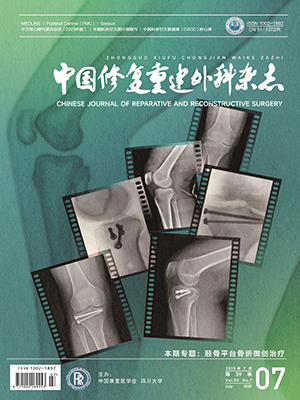| 1. |
Cucchiarini M, de Girolamo L, Filardo G, et al. Basic science of osteoarthritis. J Exp Orthop, 2016, 3(1): 22.
|
| 2. |
Boushell MK, Hung CT, Hunziker EB, et al. Current strategies for integrative cartilage repair. Connect Tissue Res, 2017, 58(5): 393-406.
|
| 3. |
Bowland P, Ingham E, Jennings L, et al. Review of the biomechanics and biotribology of osteochondral grafts used for surgical interventions in the knee. Proc Inst Mech Eng H, 2015, 229(12): 879-888.
|
| 4. |
Fischer S, Kisser A. Single-step scaffold-based cartilage repair in the knee: A systematic review. J Orthop, 2016, 13(4): 246-253.
|
| 5. |
Frenkel SR, Bradica G, Brekke JH, et al. Regeneration of articular cartilage--evaluation of osteochondral defect repair in the rabbit using multiphasic implants. Osteoarthritis Cartilage, 2005, 13(9): 798-807.
|
| 6. |
Sun K, Li R, Jiang W, et al. Comparison of three-dimensional printing and vacuum freeze-dried techniques for fabricating composite scaffolds. Biochem Biophys Res Commun, 2016, 477(4): 1085-1091.
|
| 7. |
Shi X, Zhou J, Zhao Y, et al. Gradient-regulated hydrogel for interface tissue engineering: steering simultaneous osteo/chondrogenesis of stem cells on a chip. Adv Healthc Mater, 2013, 2(6): 846-853.
|
| 8. |
Camarero-Espinosa S, Cooper-White J. Tailoring biomaterial scaffolds for osteochondral repair. Int J Pharm, 2017, 523(2): 476-489.
|
| 9. |
Lin HY, Tsai WC, Chang SH. Collagen-PVA aligned nanofiber on collagen sponge as bi-layered scaffold for surface cartilage repair. J Biomater Sci Polym Ed, 2017, 28(7): 664-678.
|
| 10. |
Su JY, Chen SH, Chen YP, et al. Evaluation of magnetic nanoparticle-labeled chondrocytes cultivated on a type Ⅱ collagen-chitosan/poly (lactic-co-glycolic) acid biphasic scaffold. Int J Mol Sci, 2017, 18(1): pii: E87.
|
| 11. |
Pouran B, Arbabi V, Bleys RL, et al. Solute transport at the interface of cartilage and subchondral bone plate: Effect of micro-architecture. J Biomech, 2017, 52: 148-154.
|
| 12. |
Nooeaid P, Salih V, Beier JP, et al. Osteochondral tissue engineering: scaffolds, stem cells and applications. J Cell Mol Med, 2012, 16(10): 2247-2270.
|
| 13. |
Izadifar Z, Chen X, Kulyk W. Strategic design and fabrication of engineered scaffolds for articular cartilage repair. J Funct Biomater, 2012, 3(4): 799-838.
|
| 14. |
Ruan SQ, Yan L, Deng J, et al. Preparation of a biphase composite scaffold and its application in tissue engineering for femoral osteochondral defects in rabbits. Int Orthop, 2017, 41(9): 1899-1908.
|
| 15. |
Sartori M, Pagani S, Ferrari A, et al. A new bi-layered scaffold for osteochondral tissue regeneration: In vitro and in vivo preclinical investigations. Mater Sci Eng C Mater Biol Appl, 2017, 70(Pt 1): 101-111.
|
| 16. |
Kon E, Roffi A, Filardo G, et al. Scaffold-based cartilage treatments: with or without cells? A systematic review of preclinical and clinical evidence. Arthroscopy, 2015, 31(4): 767-775.
|
| 17. |
Levingstone TJ, Ramesh A, Brady RT, et al. Cell-free multi-layered collagen-based scaffolds demonstrate layer specific regeneration of functional osteochondral tissue in caprine joints. Biomaterials, 2016, 87: 69-81.
|
| 18. |
Levingstone TJ, Matsiko A, Dickson GR, et al. A biomimetic multi-layered collagen-based scaffold for osteochondral repair. Acta Biomater, 2014, 10(5): 1996-2004.
|
| 19. |
Shi W, Sun M, Hu X, et al. Structurally and functionally optimized silk-fibroin-gelatin scaffold using 3D printing to repair cartilage injury in vitro and in vivo. Adv Mater, 2017, 29(29). doi: 10.1002/adma.201701089.
|
| 20. |
Filardo G, Kon E, Roffi A, et al. Scaffold-based repair for cartilage healing: a systematic review and technical note. Arthroscopy, 2013, 29(1): 174-186.
|
| 21. |
Holmes B, Zhu W, Li J, et al. Development of novel three-dimensional printed scaffolds for osteochondral regeneration. Tissue Eng Part A, 2015, 21(1-2): 403-415.
|
| 22. |
M JC, Reardon PJ, Konwarh R, et al. Mimicking hierarchical complexity of the osteochondral interface using electrospun silk-bioactive glass composites. ACS Appl Mater Interrfaces, 2017, 9(9): 8000-8013.
|
| 23. |
Vindas Bolaños RA, Cokelaere SM, Estrada McDermott JM, et al. The use of a cartilage decellularized matrix scaffold for the repair of osteochondral defects: the importance of long-term studies in a large animal model. Osteoarthritis Cartilage, 2017, 25(3): 413-420.
|
| 24. |
Vikingsson L, Claessens B, Gómez-Tejedor JA, et al. Relationship between micro-porosity, water permeability and mechanical behavior in scaffolds for cartilage engineering. J Mech Behav Biomed Mater, 2015, 48: 60-69.
|
| 25. |
Amadori S, Torricelli P, Panzavolta S, et al. Multi-layered scaffolds for osteochondral tissue engineering: in vitro response of co-cultured human mesenchymal stem cells. Macromol Biosci, 2015, 15(11): 1535-1545.
|




